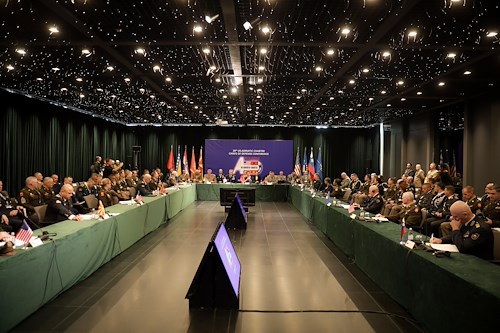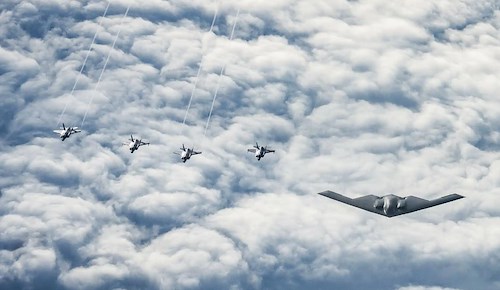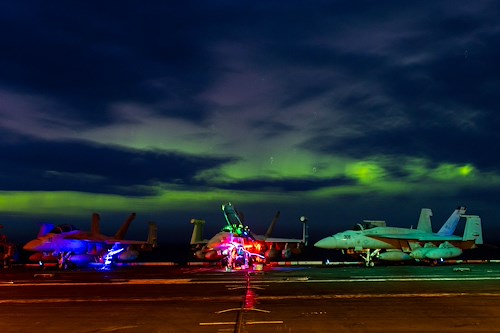Gallery contains 5 images
×
Photo 1 of 5
Bastille Day Parade Illustrates Depth of U.S.-French Alliance
President Trump visits the U.S. Embassy in Paris, France for a meet and greet with staff and service members from U.S. European Command followed by a working lunch with senior members of his delegation and U.S. Military leaders participating in the Bastille Day festivities July 13, 2017. A historic first, nearly 200 American service members will lead the Military Parade on Bastille Day, July 14, 2017, along the famous Champs-Elysées in Paris in commemoration of the U.S. entry into WWI. The French government traditionally invites a country of honor to lead the parade, which is linked to a historical event and highlights a symbolic gesture of friendship.
Photo 2 of 5
Bastille Day Parade Illustrates Depth of U.S.-French Alliance
Service members assigned to U.S. European Command pose for a group photo July 13, 2017. Nearly 200 American service members will lead the Military Parade on Bastille Day, July 14, 2017, along the famous Champs-Elysées in Paris in commemoration of the U.S. entry into WWI. The French government traditionally invites a country of honor to lead the parade, which is linked to a historical event and highlights a symbolic gesture of friendship.
Photo 3 of 5
Bastille Day Parade Illustrates Depth of U.S.-French Alliance
Nearly 200 American service members will lead the Military Parade on Bastille Day, July 14, 2017, along the famous Champs-Elysées in Paris in commemoration of the U.S. entry into WWI. The French government traditionally invites a country of honor to lead the parade, which is linked to a historical event and highlights a symbolic gesture of friendship.
Photo 4 of 5
Bastille Day Parade Illustrates Depth of U.S.-French Alliance
President Trump visits the U.S. Embassy in Paris, France for a meet and greet with staff and service members from U.S. European Command followed by a working lunch with senior members of his delegation and U.S. Military leaders participating in the Bastille Day festivities July 13, 2017. A historic first, nearly 200 American service members will lead the Military Parade on Bastille Day, July 14, 2017, along the famous Champs-Elysées in Paris in commemoration of the U.S. entry into WWI. The French government traditionally invites a country of honor to lead the parade, which is linked to a historical event and highlights a symbolic gesture of friendship.
Photo 5 of 5
Bastille Day Parade Illustrates Depth of U.S.-French Alliance
Nearly 200 American service members will lead the Military Parade on Bastille Day, July 14, 2017, along the famous Champs-Elysées in Paris in commemoration of the U.S. entry into WWI. The French government traditionally invites a country of honor to lead the parade, which is linked to a historical event and highlights a symbolic gesture of friendship.
“Lafayette, we are here.”
In July 1917, American soldiers -- newly arrived in France -- marched through Paris to pay their respects at the tomb of a man who embodied French assistance to the United States during the American Revolution -- Marie-Joseph Paul Yves Roch Gilbert du Motier, better known as the Marquis de Lafayette.
American service members will once again march through Paris as part of the Bastille Day parade down the Champs-Elysees on July 14. They represent the firm alliance between France and the United States that Lafayette epitomized in the American Revolution and the Doughboys represented during the War to End All Wars.
President Donald J. Trump and Marine Corps Gen. Joe Dunford, the chairman of the Joint Chiefs of Staff, will observe the parade and meet the American participants in it.
The United States would probably have remained a colony of England were it not for France's assistance. Lafayette served alongside General George Washington during the Revolution and French soldiers and sailors were instrumental at the Battle of Yorktown -- the victory that cemented America’s independence from Great Britain.
An Old Debt
The American soldiers of 1917 were well aware of the debt the United States owed France. America’s entry into the Great War on April 6, 1917, was viewed by many as a way for America to repay the French people for their help 140 years earlier.
And the French needed it. The Western Front stretched across France like a near 500-mile cancer. The French and the British had been fighting the Germans in the trenches since 1914 and millions had already died or been wounded.
Verdun, the Somme, Ypres, the Marne, the Aisne were all battles that ended in stalemates, but with a price in blood once unthinkable.
The Nivelle offensive of April 1917 -- named after the new commander of French forces, Gen. Robert Nivelle -- was designed to break the stalemate. The French attacked along the Chemin des Dames -- a nearly impregnable German position along a ridge. The army took about 115,000 casualties with about 28,000 dead.
And then they stopped fighting.
Men in nearly half of the French divisions on the Western Front simply refused to obey orders to return to the offensive. The French Army had lost more than a million men killed up to that point, and the failure of the Nivelle Offensive was just too much. They mutinied.
The French government replaced Nivelle with Gen. Philippe Petain, the hero of the Battle of Verdun. Petain moved to improve morale and conditions for the French soldiers. Amazingly, the Germans never heard about the mutiny.
Reinforcements
Across the continent, Russia was lurching toward peace with Germany and Austria-Hungary. That would mean more than 1 million troops could reinforce German forces on the Western Front.
All this made the arrival of American force that much more important. On June 26, 1917, the first American troops arrived in the port of St. Nazaire. There were 14,000 soldiers in what was called the 1st Provisional Division. It was provisional because the United States Army had not operated in division-sized units since the American Civil War. Later in the year, the provisional unit would double in size and become the 1st Division -- today’s famed 1st Infantry Division, the Big Red One.
Training was a problem and the troops barely knew how to march, but the arrival of the forces of the new ally was important for military and civilian morale, and the U.S. forces marched to Lafayette’s Tomb.
Parisians saw the American forces carrying their 1903 rifles and wearing the broad-brimmed campaign hats now worn by drill sergeants, drill instructors or military training instructors in the Army, Marine Corps and Air Force. The French crowds mobbed the American troops along the route, according to the memoirs of Gen. John J. Pershing, the commander of the American Expeditionary Force.
The parade was a good morale booster for a people worn down by the endless casualty lists, but it would be some time before American military might would be felt on the battlefield. The Big Red One entered the front lines in October 1917.
In time, the American contribution would be decisive. Petain recognized this and said his strategy was to “wait for the tanks and the Americans.”
They did arrive. More than 2 million soldiers, Marines and sailors served with the American Expeditionary Force in France. The numbers and their increasing combat effectiveness were instrumental in convincing the Germans to sign an armistice in November 1918.
It was not without its cost. The United States lost 117,465 dead and 204,002 wounded.
(Follow Jim Garamone on Twitter: @GaramoneDoDNews)



















